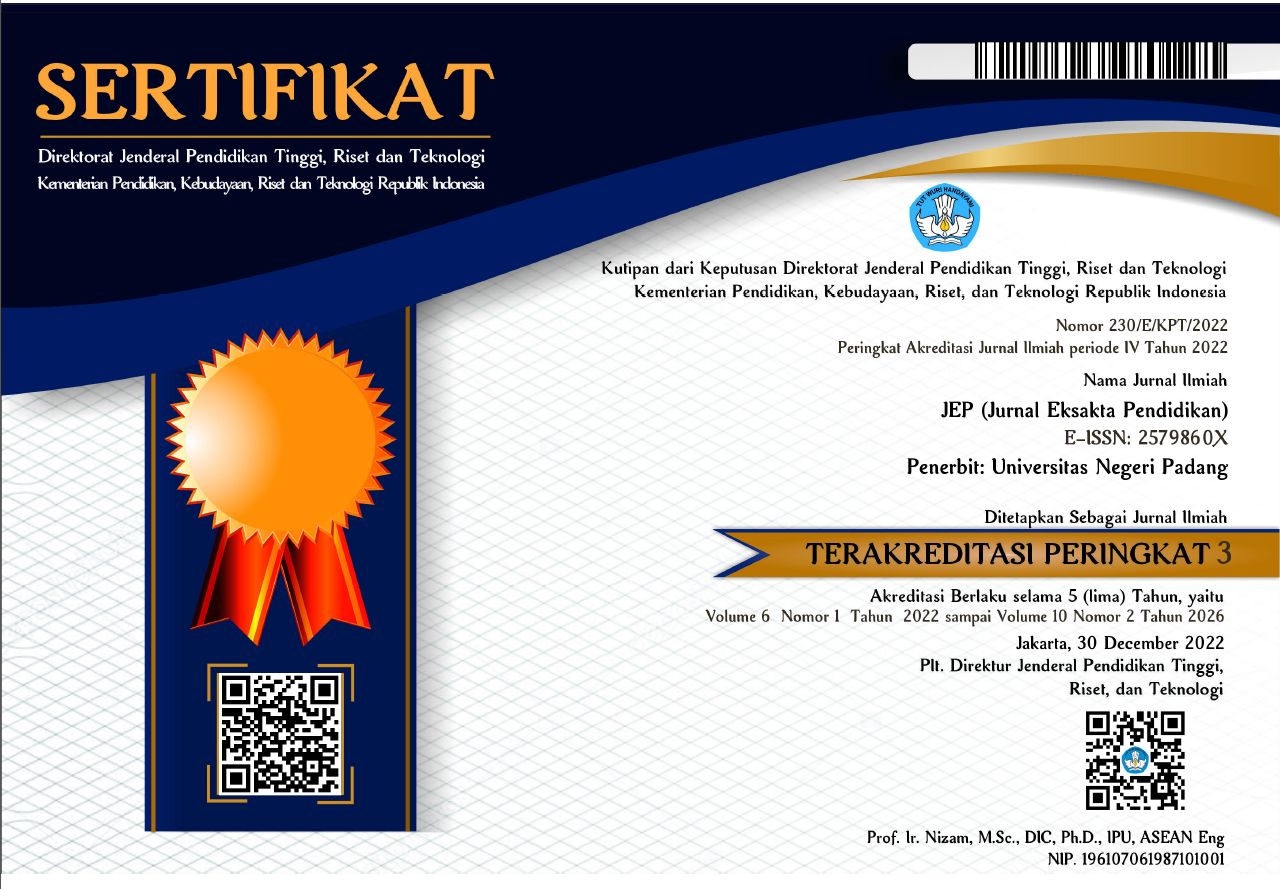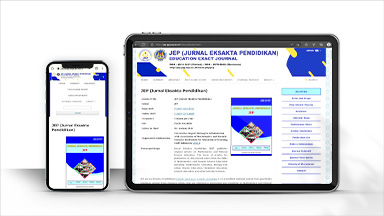Program Belajar berbasis STEM untuk Pembelajaran IPA: Tinjauan Pustaka, dengan Referensi di Indonesia
Abstract
The scenario of Industry 4.0 and 21st century skills show rapidly increase and informed. In this century, the main goal of our educational system should be able to answer students needed for living in the world. In recent years, STEM Education has received growing attention to be considered to understand STEM Education. In the South East Asia, Indonesia is one of the biggest country has a large number of human resources that should be developed. This study was aimed to examine the movement of STEM education in Indonesia within the scope of 21st century skills categories by using the content analysis method, examine best practice of STEM education for teachers by investigating engineering design skills training and reviewed the literature from 1990 to 2016 that has emphasized on development of STEM education around the world. The findings showed that STEM Education has been developed around Indonesia and has a positive impact to enhance students’ concept comprehension, literacy, and creativity. Many researches provide evidence the best practice for science teacher to implement STEM Education. STEM has a close to daily life and increase student awareness with the environment.
Downloads
References
Barrett, B. S., Moran, A. L., & Woods, J. E. (2014). Meteorology meets engineering: an interdisciplinary STEM module for middle and early secondary school students. International Journal of STEM Education, 1(1), 6-11.
Blömeke, S., Suhl, U., Kaiser, G., & Döhrmann, M. (2012). Family background, entry selectivity and opportunities to learn: What matters in primary teacher education? An international comparison of fifteen countries. Teaching and Teacher Education, 28, 44–55.
Blumenfeld, P. C., Soloway, E., Marx, R. W., Krajcik, J. S., Guzdial, M., & Palincsar, A. (1991). Motivating project-based learning: Sustaining the doing, supporting the learning. Educational Psychologist, 26(3/4), 369–398.
Blumenfeld, P., Fishman, B., Krajcik, J., Marx, R., & Soloway, E. (2000). Creating useable innovations in systemic reform: Scaling-up technology-embedded project-based science in urban schools. Educational Psychologist, 35(3), 149–164.
Burke,L.,Francis,K.,& Shanahan, M. (2014).A horizon of possibilities : a definition of STEM education. McIntyre: Vancouver.
Bybee, R. B. (2013). The case for STEM education: Chalenges and Opportunities. Arlington : National Science Teachers Association, NSTA Press.
Czerniak, C. M., Weber, W. B., Sandmann, A., & Ahern, J. (1999). A literature review of science and mathematics integration. School Science & Mathematics, 99(8), 421-430.
Costa, M. J. (2013). What does ‘student-centered’ mean and how can it be implemented? A systematic perspective. Biochemistry and Molecular Biology Education, 41(4), 267–268.
Ejiwale, J. A. (2012). Facilitating teaching and learning across STEM fields. Journal of STEM Education, 13(3), 87-94
Erlandson, C., & McVittie, J. (2001). Student voices on integrative curriculum. Middle School Journal, 33(2), 28-36.
Farwati, R., Permanasari, A., Firman, H., & Suhery, T. (2017) Integrasi Problem based learning dalam STEM education berorientasi pada aktualisasi literasi lingkungan dan kreativitas. Prosiding seminar nasional pendidikan IPA. Palembang
Farwati, R., Suhery, T., & Permanasary, A., & Firman, H. (2018) Integration of Science, Technology, Engineering and Mathematics: The Multidisciplinary Approach to Enhance the Environmental Literacy of Prospective Chemistry Teachers. Bulgarian Journal of Science EducationFitriani, D., Kaniawati, I., &
Fitriani, D. N., Kaniawati, I., & Ramalis, T. R. (2017). Creativity of junior high school’s students in designing earthquake resistant buildings. IOP Conf. Series: Journal of Physics: Conf. Series 895
Gningue, S. M., Peach, R., & Schroder, B. (2013). Developing effective mathematics teaching: Assessing content and pedagogical knowledge, student-centered teaching, and student engagement. Mathematics Enthusiast, 10(3), 621–646.
Goldsmith, L., Doerr, H., & Lewis, C. (2014). Mathematics teachers’ learning: A conceptual framework and synthesis of research. Journal of Mathematics Teacher Education, 17, 5–36.
Guzey, S. S., Moore, T. J., Harwell, M., & Moreno, M. (2016). STEM Integration in Middle School Life Science: Student Learning and Attitudes. Journal of Science Education and Technology, 25(4), 550-560.
Hinde, E. T. (2005). Revisiting curriculum integration: A fresh look at an old idea. The Social Studies, 96(3), 105-111.
Honey,M., Pearson,G.,& Schweingruber,A. (2014). STEM integrationinK- 12 education: status, prospects, and an agenda for research. Washington: National Academies Press
Jauhariyyah, F. R., Suwono, H., & Ibrohim (2017) Science, Technology, Engineering, and Mathematics Project Based Learning (STEM-PjBL) pada Pembelajaran sains. Pros. Seminar pend. IPA pascasarjana UM
Kelley, T. R., & Knowles, J. G. (2016). A conceptual framework for integrated STEM education. International Journal of STEM Education, 3(1), 1-11.
Kersting, N. B., Givvin, K. B., Thompson, B. J., Santagata, R., & Stigler, J. W. (2012). Measuring usable knowledge: Teachers’ analyses of mathematics classroom videos predict teaching quality and student learning. American Educational Research Journal, 49, 568–589.
King, D., & English, L. D. (2016). Engineering design in the primary school: applying stem concepts to build an optical instrument. International Journal of Science Education, 38(18), 2762-2794.
Marulcu, I., & Barnett, M. (2016). Impact of an engineering design-based curriculum compared to an inquiry-based curriculum on fifth graders’ content learning of simple machines. Research in Science & Technological Education, 34(1), 85-104.
McKinsey, (2016). STEM Education in the Irish System School. A report of STEM Education. Irish
Moore, T. J., & Smith, K. A. (2014). Advancing the state of the art of STEM integration. Journal of STEM Education : Innovations and Research, 15(1), 5-10.
Motschnig-Pitrik, R., & Holzinger, A. (2002). Student-centered teaching meets new media: Concept and case study. Educational Technology & Society, 5(4), 160–172.
Nurlaely, N., Permanasari, A., & Riandi, R. (2017). Student’s STEM literacy in biotechnology learning at junior high school. IOP Conf. Series: Journal of Physics: Conf. Series 895
Otero, V. K., & Gray, K. E. (2008). Attitudinal gains across multiple universities using the physics and everyday thinking curriculum. Phys Rev Spec Top-PH, 4(2), 020104. https://doi.org/10.1103/ PhysRevSTPER.4.020104 .
Permanasari, A., & Fitriani, A. (2016). Penerapan project based learning terintegrasi STEM untuk meningkatkan literasi sains siswa ditinjau dari gender. Jurnal Inovasi Pendidikan IPA, 2(2), 202- 212. doi:http://dx.doi.org/10.21831/jipi.v2i2.8561
Prima, E., C. et al (2018) STEM learning on electricity using Arduino-phet based experiment to improve 8th grade students’ STEM literacy. journal physics: conference series 1013012030
Russell, M., O’Dwyer, L., Bebell, D., & Miranda, H. (2004). Technical report for the USEIT study. Boston, MA: Boston College, Technology and Assessment Study Collaborative.
Sanders, M. (2009). STEM, STEM education, STEM mania. The Technology Teacher, 68(4), 20-26.
Sejati, B. K., Firman, H., & Kaniawati, I. (2017). STEM-Based workbook: enhancing students’ STEM competencies on lever system. AIP conference proceedings 2848, 060005 (2017): doi:10.1063/1.4983973
Savery, J. R. (2006). Overview of problem-based learning: Definitions and distinctions. Interdisciplinary Journal of Problem- Based Learning, 1(1), 9–20.
Schnittka, C. G., Evans, M. A., Won, S. G. L., & Drape, T. A. (2016). After- School Spaces: Looking for Learning in All the Right Places. Research in Science Education, 46(3), 389-412.
Shulman, L. S. (1987). Knowledge and Teaching: Foundations of the New Reform. Harvard Educational Review, 57, 1-22.
Suwarma, I. R., Firman, H., & Rustaman, N. Y. (2015) The development of technology and engineering literacy through STEM-based education. International Conference on Innovation of Engineering and Vocational Education. Atlantis Press
Suwarma, I. R., (2016) Pengaruh pembeljaran berbasis STEM pada konsep tekanan hidrostatis terhadap causal reasoning siswa SMP. Prosiding seminar nasional fisika
Tati, T., Firman, H., & Riandi, R. (2017). The effect of STEM learning through the project of designing boat model toward student STEM literacy. IOP COnf. Series: Journal of Physics Conf. Series 895
Tsupros, N., Kohler, R., & Hal linen, J. (2009). STEM education: A project to identify the missing components. Intermediate Unit 1and Carnegie Melon, Pennsylvania.
Verma, A. K., Dickerson, D., & McKinney, S. (2011). Engaging students in STEM careers with project-based learning: Marine Tech project. Technology and Engineering Teacher, 71(1), 25–31.
Vilorio, D. (2014). STEM 101:Intro to tomorow’s jobs. Occupational Outlook Quarterly. Retrieved from http:/www.stemedcoalition.org/wp content/uploads/2010/05/BLS- STEM-Jobs-report-spring-2014.pdf
Weimer, M. (2013). Learner-centered teaching: Five key changes to practice (2nd ed.). San Francisco, CA: Jossey-Bass.
Wright, G. B. (2011). Student-centered learning in higher education. International Journal of Teaching and Learning in Higher Education, 23(3), 92–97.
Wright, V. H., & Wilson, E. K. (2011). Teacher’s use of technology: Lessons learned from the teacher education program in the classroom. Southeastern Regional Association of Teacher Educators (SRATE) Journal, 20(2), 48–60.
Wendell, B. K., & Rogers, C. (2013). Engineering Design-Based Science, Science Content Performance, and Science Attitudes in Elementary School. Journal of Engineering Education, 102(4), 513-540.
Yanyan, L., Zhinan, H., Menglu, J., & Ting-Wen, C. (2016). The Effect on Pupil's Science Performance and Problem-Solving Ability through Lego: An Engineering Design-based Modeling Approach. Journal of Educational Technology & Society, 19(3) 156.
Copyright (c) 2019 Oktian Fajar Nugroho, Anna Permanasari, Harry Firman

This work is licensed under a Creative Commons Attribution 4.0 International License.

This work is licensed under a Creative Commons Attribution 4.0 International License.




_(2579-860X).png)
_(2614-1221)1.png)




